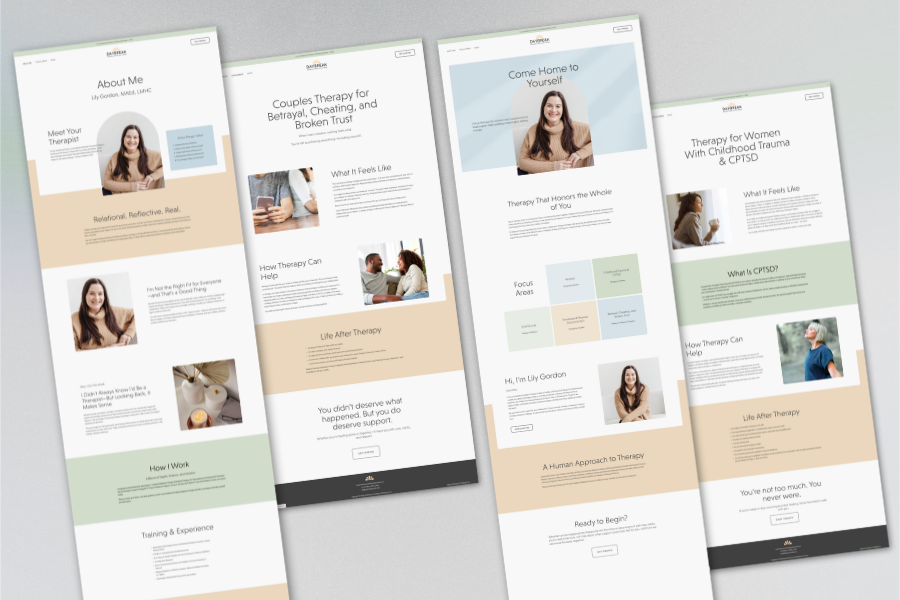Branding for Therapists: It's Easier Than You Think
A Simple 5-Step Guide to Branding Your Therapy or Coaching Practice
If you're a therapist and you've been told that you need to brand yourself and you're totally confused about what that means or immediately connect it to turning your practice into a sales pitch, I totally get it. I was reluctant too. Branding yourself, especially if your a solo practitioner, feels so "corporate."
I’m here to tell you that branding is everything. If you’re not intentionally branding, you’re still branding. Your lack of intention becomes your brand identity. Potential clients will feel your identity crisis. You’ll struggle to bring in clients because your marketing materials aren’t memorable, or you’ll attract clients you don’t want to work with because your identity is not clearly defined.
Before I say more, let’s review some definitions just so we know we are talking about the same thing.
A brand is a feature or set of features that distinguish one business from another. A brand comprises a name, tagline, logo or symbol, design, brand voice, and more. It also refers to a person’s experience when interacting with your business — as a client, social media follower, information-gatherer, or passerby.
Branding is researching, developing, and applying a distinctive feature or set of features to your business so that potential clients can associate your brand with your services. Branding is a continual process. It requires getting in touch with the heart of your clients and your business.
There are many benefits of branding a business and a full list may be better saved for a future blog post. But for now, the main idea is that branding gives your practice an identity; it gives clients something to relate to and connect with. It makes your practice memorable.
If a brand is merely a set of features representing your practice, I say, why not?
Note: If you have not yet clearly identified your ideal client, their pain points, and your value proposition, do that first. You can't create a brand identity without those things.
Your 5-Step Guide to Branding Your Practice
Step 1: Make a List of Buzzwords
Write down all the impressions you want to make about your practice or your work. What do you want clients to know? Are you relatable, curious, and creative? Do you want them to feel accepted, acknowledged, and supported? Does your work focus on actions and behavior? Or perhaps healing and soul work?
Write a list of words that will resonate with your ideal clients to connect to you and remember you. Below is an example list for a therapist who works with female artists and creatives. Her primary goal is to empower women artists to find freedom in their chosen craft.
Step 2: Identify Your Brand Inspiration
What inspires your work? Is there a quote, image, story, or idea that gets you fired up? What makes you feel excited about doing this work? What kind of message do you want clients to get from you? Here’s an example quote for the therapist who works with female creatives.
Don’t overthink this. If something doesn’t immediately come to mind, save it for later. It’ll come to you.
Step 3: Create a Color Palette
You’ll need to pick colors to use on your branding images, such as logos, business cards, your website, etc.
Think about how certain colors make you feel. For the therapist I’m using as an example, she wanted colors that evoked femininity, strength, and confidence. She also wanted a bold color palette that might appeal to artists and creatives. The color scheme pictured uses soft peach and pink colors to represent femininity, and bold teal greens to radiate confidence and strength. The other colors are simply there to complement the main colors. This therapist chose a warm white, as opposed to a stark white, to create a comforting feel.
If you’re having trouble getting started, Pinterest is an awesome resource. Just type in the search bar “color palette” or “color scheme.” If there is one or two colors you know you like but aren’t sure how to combine other colors, just type “color palette [your color].” You don’t need as many as I have here. Start with something dark, something light, and one to accent. If you feel like you need more, you can add them later.
Step 4: Social Media
Your social media feed(s) should also reflect your brand authentically. Here’s a mock-up of what the Instagram account might look like for the example therapist. You can see that the same color palette is used, and the content is targeting her ideal clients. It’s bold, feminine, artsy, and warm.
Step 5: Logos
Once you’ve got some inspiration, buzzwords, and colors picked out, you can start your logo design. Your logo does not need to be complicated or fancy. You can simply use unique typography without an image, or just a shape behind your name. Canva is an easy-to-use tool for non-designer types if you’d like to design one yourself. If you would like someone else to create one for you at an affordable price, check out Etsy’s options.
Be sure to consider variations on your primary logo as I have here. These can be used on business cards, social media sharing images, the mobile version of your website, and other marketing materials.
The example therapist wanted a simple logo because her other branding images are bold. We focused on keeping the logo modern and minimalist while using her brand colors.
That’s it!
Now, just use your brand features consistently across all your marketing channels.
Suppose you're still asking why branding is essential. In that case, I challenge you with a counter-argument: Is there any time branding isn't necessary?
Your branding makes an emotional statement every time an ideal client stumbles across your business. The impact of that statement is what determines whether a potential client will become an actual client. I've said it before, and I'll repeat it: branding is everything.






































